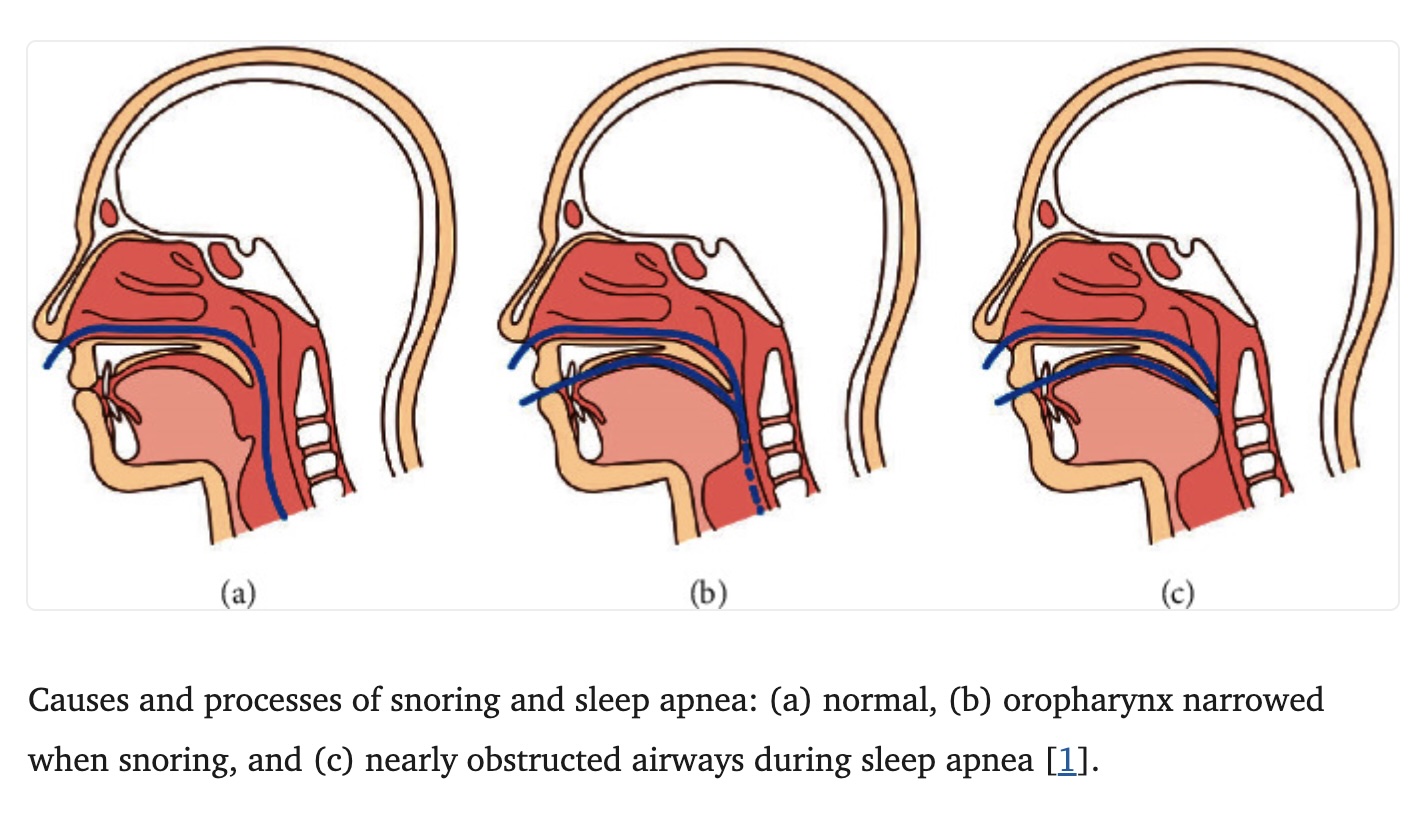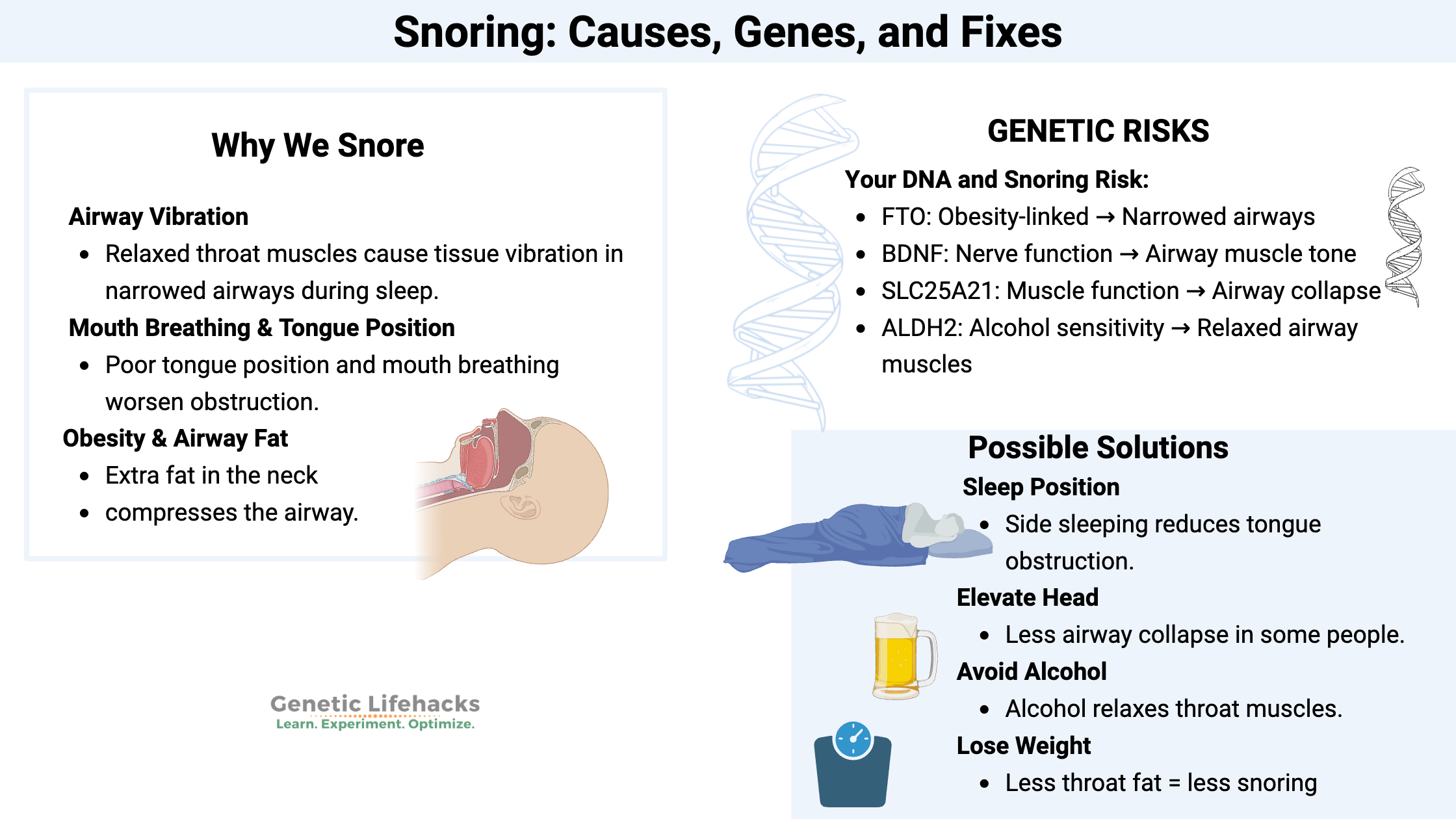Key takeaways:
~ Snoring is caused by relaxed throat muscles narrowing the airway and vibrating during sleep.
~ Genetics play a role—certain genes affect airway structure, fat distribution, and muscle control.
~ Snoring doesn’t always mean sleep apnea, and loudness isn’t linked to severity.
~ Lifestyle changes like side-sleeping, weight loss, and avoiding alcohol can help to reduce snoring.
What causes snoring? And how can you fix it?
Snoring is caused by vibration of the soft tissues in the upper airway during sleep. This vibration occurs because the muscles in these areas relax too much, causing the tissues to block the passage of air and vibrate with restricted airflow.
Snoring without sleep apnea can lead to fragmented sleep. While often a minor sleep problem for the person snoring, it can wreak havoc on the sleep of your spouse or partner. Studies show that about 35-45% of men and up to 28% of women are habitual snorers. [ref]
Essentially, snoring is caused by tissue sagging in your airway, which partially blocks your airway. This can be due to the tongue being in the wrong position when breathing through the mouth, or it can be due to adenoid hypertrophy causing narrowing through the nasal passages. Increased fat mass in the throat can also cause narrowing. All of these combine with the decrease in muscle tension during sleep to cause the vibration phenomenon.[ref]

A recent study showed that louder snoring isn’t due to a more obstructed airway, but to more effort in breathing, called ventilatory effort. Interestingly, there doesn’t seem to be a link between the loudness of snoring and the likelihood of having sleep apnea.[ref]
Other studies link snoring and even sleep apnea, in some cases, to breathing in a larger volume of air than average during sleep. This causes changes in carbon dioxide levels, while oxygen levels often remain in the normal range.
Sleep apnea overlap:
Snoring is a hallmark of obstructive sleep apnoea (OSA), which is a sleep-related breathing disorder. Almost everyone with obstructive sleep apnea snores; however, not everyone who snores has sleep apnea. [ref] Interestingly, sleep apnea patients often have low CO2 at night with high CO2 during the daytime. [ref][ref] I’ll cover sleep apnea in depth in another article.
Genetic component of snoring:
Let’s take a look at which genes increase or decrease the relative risk of snoring. Genetic studies can often point to an underlying cause.
A large study involving more than 400,000 people identified a number of genes that were statistically associated with snoring. Another large genome-wide study found that several common genetic variants were associated with snoring.
Here’s a summary of the two large studies on snoring: [ref][ref]
- BDNF is involved in nerve cell function in the brain, suggesting a possible role for neurological dysfunction in snoring.
- FTO gene variants are associated with an increased relative risk of higher BMI and obesity. Increased fat surrounding the upper airways can lead to pharyngeal collapse in snoring.
- PAX9 was also identified as a likely gene involved in snoring. The PAX9 gene is associated with the structure of the face, and researchers think that structural abnormalities in the upper airways are associated with this gene.
- KCNQ5 encodes a potassium ion channel that regulates neuronal firing. It’s important for synaptic inhibition and smooth muscle function.
- The ALDH2 gene is involved in aldehyde metabolism. It is best known for its role in alcohol metabolism, but ALDH2 is also important in atherosclerosis and bile acid metabolism through the metabolism of aldehydes derived from lipid peroxidation. [ref][ref]
- SLC25A21 was strongly associated with snoring. SLC25A21 is a solute carrier, and mutations in the gene cause spinal muscular atrophy-like disease. Researchers think that the SLC25A21 variants contribute to the dysfunction of the genioglossus muscles.
So we have genes involved in the way that nerves work in controlling the muscles in the upper airways as well as the structure of the head/face. Plus, we have genes involved in increased risk of fat mass, which could result in narrowed airways.
Mendelian randomization studies are used to determine if a phenotype is causal for something with which there is an association. In this case, Mendelian randomization studies show that genetic variants related to obesity are also causal for snoring.[ref]
However, Mendelian randomization studies also show that the observed connection between snoring and stroke, high blood pressure, and heart failure is due to the association with obesity rather than snoring being causal.[ref]
Genotype report: Snoring
Access this content:
An active subscription is required to access this content.
Lifehacks to Reduce Snoring
While genetics sets the stage, lifestyle adjustments may help to mitigate snoring.
Solutions for snoring:
Here are some things to try that are backed by research:[ref]
Sleep on your side: Prevents tongue/base-of-throat collapse. Use a body pillow to maintain position and keep you from rolling over on your back.
Possible genetic connection: KCNQ5 or other neuron/muscle variants
Elevate your head: Elevating your head may help to reduce airway obstruction, although this tends to be more effective in people who have snoring plus sleep apnea.[ref]
Possible genetic connection: KCNQ5 or other neuron/muscle variants
Avoid alcohol before bed: Alcohol and other sedatives relax your throat muscles and increase snoring.
Possible genetic connection: ALDH2
Lose weight: One of the biggest risk factors for snoring is obesity.[ref] Additional fat in your throat area can increase snoring. Weight loss, if you are overweight, may help.
Possible genetic connection: FTO
Mandibular advancement device: A randomized clinical trial looked at the effect of a mandibular advancement device compared to a CPAP plus positional therapy for snoring. The mandibular advancement device was almost twice as likely to be effective.[ref]
More alternative snoring hacks (not necessarily research-backed):
Buteyko breathing: Buteyko breathing is a technique to retrain breathing patterns by reducing the amount of air inhaled and promoting nasal breathing. It involves taking deeper, slower breaths through the nose, utilizing the diaphragm, and incorporating breath-holding exercises. Read more about the connection to snoring here.
Myofunctional therapy exercises: These exercises help to strengthen and retrain the tongue muscles. If you snore with your mouth open, the tongue can relax back and cause airway restriction. Exercises specific to strengthening the muscles may help. Read more about it here.
Mouth taping: This involves using perforated tape to keep the mouth closed at night. Look for a tape that is made specifically for mouth taping.
Essential oil spray or gargle: A clinical trial found that an essential oil gargle that contained lemon, mint, eucalyptus, lemon balm, clove, fennel, and thyme reduced snoring in 82% of patients.[ref] The brand used in the trial was Essential Health Helps Stop Snoring spray.
Humidification: Using a humidifier can help if dry air is contributing to snoring by preventing the throat and nose from drying out and becoming congested.
Nasal breathing exercises: Here’s a video from a chiropractor on breathing and tongue exercises for snoring. Ask your own doctor if you have questions about the exercises, especially if you have neck issues.
Recap of your genes:
| Gene | RS ID | Your Genotype | Effect Allele | Effect Allele Frequency | Notes About Effect Allele |
|---|---|---|---|---|---|
| BDNF | rs6265 | -- | T | 0.18 | decreased BDNF levels, increased risk of habitual snoring |
| ALDH2 | rs671 | -- | A | 0.006 | increased relative risk of snoring |
| KCNQ5 | rs947612 | -- | A | 0.69 | increased relative risk of snoring |
| DLEU7 | rs592333 | -- | A | 0.53 | decreased relative risk of snoring |
| BCL2 | rs4987719 | -- | C | 0.97 | decreased relative risk of snoring |
| POC5 | rs2307111 | -- | T | 0.55 | increased relative risk of snoring |

